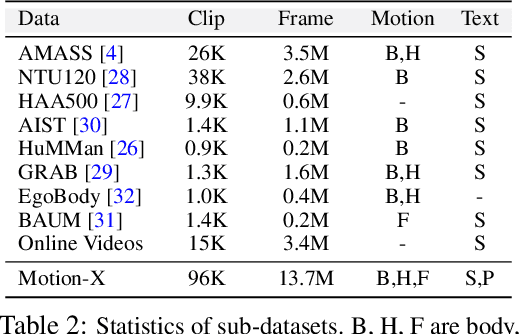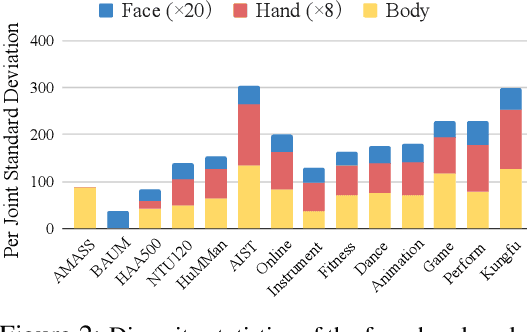Shunlin Lu
Go to Zero: Towards Zero-shot Motion Generation with Million-scale Data
Jul 09, 2025Abstract:Generating diverse and natural human motion sequences based on textual descriptions constitutes a fundamental and challenging research area within the domains of computer vision, graphics, and robotics. Despite significant advancements in this field, current methodologies often face challenges regarding zero-shot generalization capabilities, largely attributable to the limited size of training datasets. Moreover, the lack of a comprehensive evaluation framework impedes the advancement of this task by failing to identify directions for improvement. In this work, we aim to push text-to-motion into a new era, that is, to achieve the generalization ability of zero-shot. To this end, firstly, we develop an efficient annotation pipeline and introduce MotionMillion-the largest human motion dataset to date, featuring over 2,000 hours and 2 million high-quality motion sequences. Additionally, we propose MotionMillion-Eval, the most comprehensive benchmark for evaluating zero-shot motion generation. Leveraging a scalable architecture, we scale our model to 7B parameters and validate its performance on MotionMillion-Eval. Our results demonstrate strong generalization to out-of-domain and complex compositional motions, marking a significant step toward zero-shot human motion generation. The code is available at https://github.com/VankouF/MotionMillion-Codes.
ARMO: Autoregressive Rigging for Multi-Category Objects
Mar 26, 2025Abstract:Recent advancements in large-scale generative models have significantly improved the quality and diversity of 3D shape generation. However, most existing methods focus primarily on generating static 3D models, overlooking the potentially dynamic nature of certain shapes, such as humanoids, animals, and insects. To address this gap, we focus on rigging, a fundamental task in animation that establishes skeletal structures and skinning for 3D models. In this paper, we introduce OmniRig, the first large-scale rigging dataset, comprising 79,499 meshes with detailed skeleton and skinning information. Unlike traditional benchmarks that rely on predefined standard poses (e.g., A-pose, T-pose), our dataset embraces diverse shape categories, styles, and poses. Leveraging this rich dataset, we propose ARMO, a novel rigging framework that utilizes an autoregressive model to predict both joint positions and connectivity relationships in a unified manner. By treating the skeletal structure as a complete graph and discretizing it into tokens, we encode the joints using an auto-encoder to obtain a latent embedding and an autoregressive model to predict the tokens. A mesh-conditioned latent diffusion model is used to predict the latent embedding for conditional skeleton generation. Our method addresses the limitations of regression-based approaches, which often suffer from error accumulation and suboptimal connectivity estimation. Through extensive experiments on the OmniRig dataset, our approach achieves state-of-the-art performance in skeleton prediction, demonstrating improved generalization across diverse object categories. The code and dataset will be made public for academic use upon acceptance.
MotionStreamer: Streaming Motion Generation via Diffusion-based Autoregressive Model in Causal Latent Space
Mar 19, 2025Abstract:This paper addresses the challenge of text-conditioned streaming motion generation, which requires us to predict the next-step human pose based on variable-length historical motions and incoming texts. Existing methods struggle to achieve streaming motion generation, e.g., diffusion models are constrained by pre-defined motion lengths, while GPT-based methods suffer from delayed response and error accumulation problem due to discretized non-causal tokenization. To solve these problems, we propose MotionStreamer, a novel framework that incorporates a continuous causal latent space into a probabilistic autoregressive model. The continuous latents mitigate information loss caused by discretization and effectively reduce error accumulation during long-term autoregressive generation. In addition, by establishing temporal causal dependencies between current and historical motion latents, our model fully utilizes the available information to achieve accurate online motion decoding. Experiments show that our method outperforms existing approaches while offering more applications, including multi-round generation, long-term generation, and dynamic motion composition. Project Page: https://zju3dv.github.io/MotionStreamer/
Motion-X++: A Large-Scale Multimodal 3D Whole-body Human Motion Dataset
Jan 09, 2025



Abstract:In this paper, we introduce Motion-X++, a large-scale multimodal 3D expressive whole-body human motion dataset. Existing motion datasets predominantly capture body-only poses, lacking facial expressions, hand gestures, and fine-grained pose descriptions, and are typically limited to lab settings with manually labeled text descriptions, thereby restricting their scalability. To address this issue, we develop a scalable annotation pipeline that can automatically capture 3D whole-body human motion and comprehensive textural labels from RGB videos and build the Motion-X dataset comprising 81.1K text-motion pairs. Furthermore, we extend Motion-X into Motion-X++ by improving the annotation pipeline, introducing more data modalities, and scaling up the data quantities. Motion-X++ provides 19.5M 3D whole-body pose annotations covering 120.5K motion sequences from massive scenes, 80.8K RGB videos, 45.3K audios, 19.5M frame-level whole-body pose descriptions, and 120.5K sequence-level semantic labels. Comprehensive experiments validate the accuracy of our annotation pipeline and highlight Motion-X++'s significant benefits for generating expressive, precise, and natural motion with paired multimodal labels supporting several downstream tasks, including text-driven whole-body motion generation,audio-driven motion generation, 3D whole-body human mesh recovery, and 2D whole-body keypoints estimation, etc.
ScaMo: Exploring the Scaling Law in Autoregressive Motion Generation Model
Dec 19, 2024Abstract:The scaling law has been validated in various domains, such as natural language processing (NLP) and massive computer vision tasks; however, its application to motion generation remains largely unexplored. In this paper, we introduce a scalable motion generation framework that includes the motion tokenizer Motion FSQ-VAE and a text-prefix autoregressive transformer. Through comprehensive experiments, we observe the scaling behavior of this system. For the first time, we confirm the existence of scaling laws within the context of motion generation. Specifically, our results demonstrate that the normalized test loss of our prefix autoregressive models adheres to a logarithmic law in relation to compute budgets. Furthermore, we also confirm the power law between Non-Vocabulary Parameters, Vocabulary Parameters, and Data Tokens with respect to compute budgets respectively. Leveraging the scaling law, we predict the optimal transformer size, vocabulary size, and data requirements for a compute budget of $1e18$. The test loss of the system, when trained with the optimal model size, vocabulary size, and required data, aligns precisely with the predicted test loss, thereby validating the scaling law.
MotionCLR: Motion Generation and Training-free Editing via Understanding Attention Mechanisms
Oct 24, 2024Abstract:This research delves into the problem of interactive editing of human motion generation. Previous motion diffusion models lack explicit modeling of the word-level text-motion correspondence and good explainability, hence restricting their fine-grained editing ability. To address this issue, we propose an attention-based motion diffusion model, namely MotionCLR, with CLeaR modeling of attention mechanisms. Technically, MotionCLR models the in-modality and cross-modality interactions with self-attention and cross-attention, respectively. More specifically, the self-attention mechanism aims to measure the sequential similarity between frames and impacts the order of motion features. By contrast, the cross-attention mechanism works to find the fine-grained word-sequence correspondence and activate the corresponding timesteps in the motion sequence. Based on these key properties, we develop a versatile set of simple yet effective motion editing methods via manipulating attention maps, such as motion (de-)emphasizing, in-place motion replacement, and example-based motion generation, etc. For further verification of the explainability of the attention mechanism, we additionally explore the potential of action-counting and grounded motion generation ability via attention maps. Our experimental results show that our method enjoys good generation and editing ability with good explainability.
Story3D-Agent: Exploring 3D Storytelling Visualization with Large Language Models
Aug 21, 2024



Abstract:Traditional visual storytelling is complex, requiring specialized knowledge and substantial resources, yet often constrained by human creativity and creation precision. While Large Language Models (LLMs) enhance visual storytelling, current approaches often limit themselves to 2D visuals or oversimplify stories through motion synthesis and behavioral simulation, failing to create comprehensive, multi-dimensional narratives. To this end, we present Story3D-Agent, a pioneering approach that leverages the capabilities of LLMs to transform provided narratives into 3D-rendered visualizations. By integrating procedural modeling, our approach enables precise control over multi-character actions and motions, as well as diverse decorative elements, ensuring the long-range and dynamic 3D representation. Furthermore, our method supports narrative extension through logical reasoning, ensuring that generated content remains consistent with existing conditions. We have thoroughly evaluated our Story3D-Agent to validate its effectiveness, offering a basic framework to advance 3D story representation.
MotionLLM: Understanding Human Behaviors from Human Motions and Videos
May 30, 2024Abstract:This study delves into the realm of multi-modality (i.e., video and motion modalities) human behavior understanding by leveraging the powerful capabilities of Large Language Models (LLMs). Diverging from recent LLMs designed for video-only or motion-only understanding, we argue that understanding human behavior necessitates joint modeling from both videos and motion sequences (e.g., SMPL sequences) to capture nuanced body part dynamics and semantics effectively. In light of this, we present MotionLLM, a straightforward yet effective framework for human motion understanding, captioning, and reasoning. Specifically, MotionLLM adopts a unified video-motion training strategy that leverages the complementary advantages of existing coarse video-text data and fine-grained motion-text data to glean rich spatial-temporal insights. Furthermore, we collect a substantial dataset, MoVid, comprising diverse videos, motions, captions, and instructions. Additionally, we propose the MoVid-Bench, with carefully manual annotations, for better evaluation of human behavior understanding on video and motion. Extensive experiments show the superiority of MotionLLM in the caption, spatial-temporal comprehension, and reasoning ability.
HumanTOMATO: Text-aligned Whole-body Motion Generation
Oct 19, 2023Abstract:This work targets a novel text-driven whole-body motion generation task, which takes a given textual description as input and aims at generating high-quality, diverse, and coherent facial expressions, hand gestures, and body motions simultaneously. Previous works on text-driven motion generation tasks mainly have two limitations: they ignore the key role of fine-grained hand and face controlling in vivid whole-body motion generation, and lack a good alignment between text and motion. To address such limitations, we propose a Text-aligned whOle-body Motion generATiOn framework, named HumanTOMATO, which is the first attempt to our knowledge towards applicable holistic motion generation in this research area. To tackle this challenging task, our solution includes two key designs: (1) a Holistic Hierarchical VQ-VAE (aka H$^2$VQ) and a Hierarchical-GPT for fine-grained body and hand motion reconstruction and generation with two structured codebooks; and (2) a pre-trained text-motion-alignment model to help generated motion align with the input textual description explicitly. Comprehensive experiments verify that our model has significant advantages in both the quality of generated motions and their alignment with text.
Motion-X: A Large-scale 3D Expressive Whole-body Human Motion Dataset
Jul 03, 2023



Abstract:In this paper, we present Motion-X, a large-scale 3D expressive whole-body motion dataset. Existing motion datasets predominantly contain body-only poses, lacking facial expressions, hand gestures, and fine-grained pose descriptions. Moreover, they are primarily collected from limited laboratory scenes with textual descriptions manually labeled, which greatly limits their scalability. To overcome these limitations, we develop a whole-body motion and text annotation pipeline, which can automatically annotate motion from either single- or multi-view videos and provide comprehensive semantic labels for each video and fine-grained whole-body pose descriptions for each frame. This pipeline is of high precision, cost-effective, and scalable for further research. Based on it, we construct Motion-X, which comprises 13.7M precise 3D whole-body pose annotations (i.e., SMPL-X) covering 96K motion sequences from massive scenes. Besides, Motion-X provides 13.7M frame-level whole-body pose descriptions and 96K sequence-level semantic labels. Comprehensive experiments demonstrate the accuracy of the annotation pipeline and the significant benefit of Motion-X in enhancing expressive, diverse, and natural motion generation, as well as 3D whole-body human mesh recovery.
 Add to Chrome
Add to Chrome Add to Firefox
Add to Firefox Add to Edge
Add to Edge